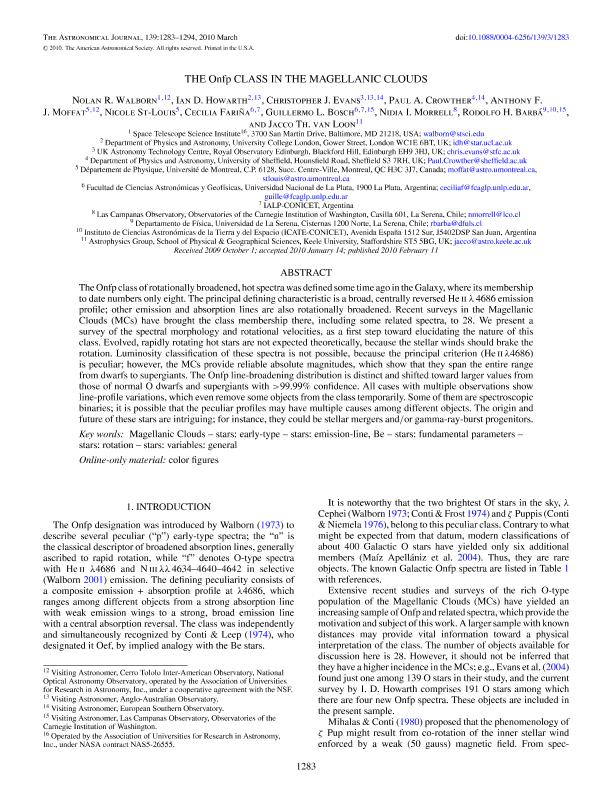Mostrar el registro sencillo del ítem
dc.contributor.author
Walborn, Nolan R.
dc.contributor.author
Howarth, Ian D.
dc.contributor.author
Evans, Christopher J.
dc.contributor.author
Crowther, Paul A.
dc.contributor.author
Moffat, Anthony F. J.
dc.contributor.author
St Louis, Nicole
dc.contributor.author
Fariña, Cecilia

dc.contributor.author
Bosch, Guillermo Luis

dc.contributor.author
Morrell, Nidia Irene

dc.contributor.author
Barba, Rodolfo Hector

dc.contributor.author
van Loon, Jacco Th.
dc.date.available
2016-12-16T14:07:36Z
dc.date.issued
2010-03
dc.identifier.citation
Walborn, Nolan R.; Howarth, Ian D.; Evans, Christopher J.; Crowther, Paul A.; Moffat, Anthony F. J.; et al.; The Onfp class in the Magellanic Clouds; Iop Publishing; Astronomical Journal; 139; 3-2010; 1283-1294
dc.identifier.issn
0004-6256
dc.identifier.uri
http://hdl.handle.net/11336/9568
dc.description.abstract
The Onfp class of rotationally broadened, hot spectra was defined some time ago in the Galaxy, where its membership to date numbers only eight. The principal defining characteristic is a broad, centrally reversed He ii λ 4686 emission profile; other emission and absorption lines are also rotationally broadened. Recent surveys in the Magellanic Clouds (MCs) have brought the class membership there, including some related spectra, to 28. We present a survey of the spectral morphology and rotational velocities, as a first step toward elucidating the nature of this class. Evolved, rapidly rotating hot stars are not expected theoretically, because the stellar winds should brake the rotation. Luminosity classification of these spectra is not possible, because the principal criterion (He ii λ4686) is peculiar; however, the MCs provide reliable absolute magnitudes, which show that they span the entire range from dwarfs to supergiants. The Onfp line-broadening distribution is distinct and shifted toward larger values from those of normal O dwarfs and supergiants with >99.99% confidence. All cases with multiple observations show line-profile variations, which even remove some objects from the class temporarily. Some of them are spectroscopic binaries; it is possible that the peculiar profiles may have multiple causes among different objects. The origin and future of these stars are intriguing; for instance, they could be stellar mergers and/or gamma-ray-burst progenitors.
dc.format
application/pdf
dc.language.iso
eng
dc.publisher
Iop Publishing

dc.rights
info:eu-repo/semantics/openAccess
dc.rights.uri
https://creativecommons.org/licenses/by-nc-sa/2.5/ar/
dc.subject
Magellanic Clouds, Stars: Early-Type
dc.subject
Stars Emission-Line
dc.subject
Stars Fundamental Parameters
dc.subject
Stars Rotation
dc.subject
Stars: Variables
dc.subject
Be
dc.subject.classification
Otras Ciencias Naturales y Exactas

dc.subject.classification
Otras Ciencias Naturales y Exactas

dc.subject.classification
CIENCIAS NATURALES Y EXACTAS

dc.subject.classification
Astronomía

dc.subject.classification
Ciencias Físicas

dc.subject.classification
CIENCIAS NATURALES Y EXACTAS

dc.title
The Onfp class in the Magellanic Clouds
dc.type
info:eu-repo/semantics/article
dc.type
info:ar-repo/semantics/artículo
dc.type
info:eu-repo/semantics/publishedVersion
dc.date.updated
2016-12-14T15:26:14Z
dc.journal.volume
139
dc.journal.pagination
1283-1294
dc.journal.pais
Reino Unido

dc.description.fil
Fil: Walborn, Nolan R.. Space Telescope Science Institute; Estados Unidos
dc.description.fil
Fil: Howarth, Ian D.. University College London; Estados Unidos
dc.description.fil
Fil: Evans, Christopher J.. Royal Observatory Edinburgh. Astronomy Technology Centre; Reino Unido
dc.description.fil
Fil: Crowther, Paul A.. University of Sheffield. Department of Physics and Astronomy; Reino Unido
dc.description.fil
Fil: Moffat, Anthony F. J.. University Of Montreal; Canadá
dc.description.fil
Fil: St Louis, Nicole. University Of Montreal; Canadá
dc.description.fil
Fil: Fariña, Cecilia. Universidad Nacional de la Plata. Facultad de Ciencias Astronómicas y Geofísicas; Argentina. Consejo Nacional de Investigaciones Científicas y Técnicas. Centro Científico Tecnológico La Plata. Instituto de Astrofísica de La Plata; Argentina
dc.description.fil
Fil: Bosch, Guillermo Luis. Universidad Nacional de la Plata. Facultad de Ciencias Astronómicas y Geofísicas; Argentina. Consejo Nacional de Investigaciones Científicas y Técnicas. Centro Científico Tecnológico La Plata. Instituto de Astrofísica de La Plata; Argentina
dc.description.fil
Fil: Morrell, Nidia Irene. Observatorio Las Campanas; Chile
dc.description.fil
Fil: Barba, Rodolfo Hector. Universidad de la Serena. Facultad de Ciencias; Chile. Consejo Nacional de Investigaciones CientiÂficas y Tecnicas. Centro Cientifico Tecnologico San Juan. Instituto de Ciencias Astronomicas de la Tierra y del Espacio; Argentina
dc.description.fil
Fil: van Loon, Jacco Th.. Keele University. School of Physical & Geographical Sciences; Reino Unido
dc.journal.title
Astronomical Journal

dc.relation.alternativeid
info:eu-repo/semantics/altIdentifier/url/http://adsabs.harvard.edu/abs/2010AJ....139.1283W
dc.relation.alternativeid
info:eu-repo/semantics/altIdentifier/url/https://arxiv.org/abs/1001.4032
dc.relation.alternativeid
info:eu-repo/semantics/altIdentifier/url/http://iopscience.iop.org/article/10.1088/0004-6256/139/3/1283/meta
dc.relation.alternativeid
info:eu-repo/semantics/altIdentifier/doi/http://www.dx.doi.org/10.1088/0004-6256/139/3/1283
Archivos asociados
